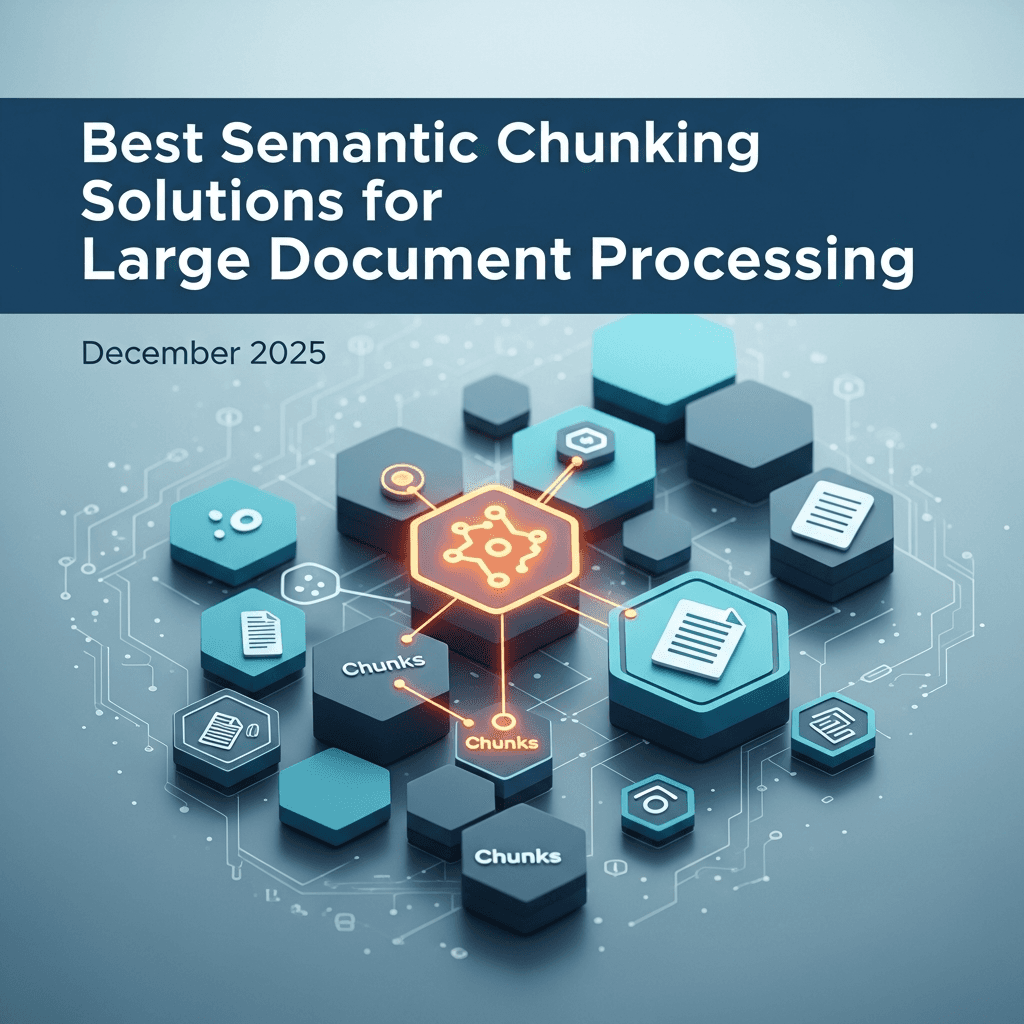8 MIN READ
Sep 29, 2025
Hyperscience Reviews, Pricing, and Alternatives
Kushal Byatnal
Co-founder, CEO
Hyperscience has become a major player in the enterprise document processing space, but its template-based approach and complex pricing structure aren't the right fit for every organization. If you're looking at intelligent document processing solutions, you need to understand exactly what you're signing up for and what other options exist. Here's the breakdown of Hyperscience's features, limitations, costs, and the leading alternatives that might better match your team's needs.
TLDR:
Hyperscience still requires significant configuration or template work for many document types, newer releases reduce but don’t eliminate the maintenance burden
Pricing is not officially disclosed; some user reviews mention per-page charges up to $1.50, but actual costs may vary and should be confirmed directly with the vendor.
With proper configuration, high extraction and automation rates (up to 99.5% and 98%, respectively) are achievable in production environments.
Extend offers LLM-powered document understanding that achieves >99% accuracy in minutes without template creation
What is Hyperscience and How Does it Work?

Hyperscience is a document processing product that offers intelligent automation features for processing structured and semi-structured documents. The company targets organizations handling high-volume document workflows, focusing primarily on enterprise environments that require automated data extraction from forms, invoices, and similar document types.
The product relies on machine learning models and OCR technology to process documents through its proprietary architecture. The Hyperscience Hypercell applies AI and ML to all the documents that flow through an organization. It can reach high accuracy rates, but only after extensive training, tuning, and ongoing maintenance.
The system provides confidence levels for extractions and queues items with low confidence for manual review. This human-in-the-loop approach is necessary but can slow throughput and increase labor costs, especially as document volumes scale and accuracy numbers stay stagnant, adding hidden operational expense.
The intelligent document processing market is rapidly evolving beyond template-based solutions toward more flexible AI-driven approaches that can handle document variations without extensive configuration.
Hyperscience positions itself as an enterprise solution for organizations that can invest substantial time in setup and configuration. The system works best when you have predictable document types that don't change frequently.
Hyperscience Features
Hyperscience uses machine learning models to provide document classification and data extraction functionality. The system processes structured and semi-structured documents and includes features for handling handwritten text alongside printed materials.
It does not always require template creation, especially for common or previously seen document types. However, classification accuracy can be boosted by model training and configuration, which may include creating templates for highly specialized use cases
The system offers out-of-the-box and customizable tasks, workflows, and connectors that plug into existing document processes. Users can configure extraction templates and workflows to match their specific document types. The product includes data validation and enrichment features to check extracted information against business rules.
Integration occurs through an API and includes pre-trained models for common document types. However, even with pre-trained models, you'll likely need to create custom templates for your specific document variations.
Hyperscience handles different document types, including invoices, contracts, purchase orders, and support tickets. The system supports multiple file formats and can work with scanned documents as well as digital files.
Feature Category | Hyperscience Feature | Set-up Requirements |
|---|---|---|
Document Classification | ML-based classification | Often needs configuration or template updates for changing or specialized documents |
Data Extraction | OCR + ML extraction | Pre-trained models for common docs; fine-tuning optional |
Handwriting Recognition | Advanced handwritten text ML | High out-of-box accuracy; edge cases may need tuning |
Workflow Automation | Visual blocks, low-code flows | Drag-and-drop assembly; no heavy manual setup required |
API Integration | API-first, configurable blocks | Plug-and-play integration for most scenarios |
The template requirement becomes particularly challenging when you're dealing with documents that have evolved over time. Every version change means more configuration work.
The system does provide validation features that can catch extraction errors before they impact downstream processes. This helps maintain data quality but adds another layer of configuration complexity.
Hyperscience Key Limitations and Gaps
The biggest limitation in earlier Hyperscience deployments was the need to create templates for every form type and version.
Hyperscience has introduced more AI-driven features, but customers still report that specialized or frequently changing documents require ongoing configuration, meaning template headaches haven’t gone away.
This template dependency creates ongoing maintenance overhead as document formats evolve. When your vendors change their invoice formats or your forms get updated, you're back to template creation mode.
Pricing presents another major challenge. Some users report high costs, including a per-page charge of $1.50. The licensing structure is opaque, with pricing heavily dependent on volume processed through the system, making it difficult for organizations to predict costs as they scale.
As the platform evolves rapidly, new features and UI updates are introduced frequently. While these improvements bring expanded capabilities, they can require some user retraining and process updates, particularly during major version upgrades
While the system shows stability after training, users express a need for enhanced features like character and location corrections, as well as improvements in language support and dictionary validations. Organizations handling multilingual documents may find these limitations particularly restrictive.
Hyperscience has added low-code/no-code features, but customers report that building and maintaining complex workflows still requires expert configuration and ongoing support, limiting true hands-off automation.
Why Extend is Different: Extend eliminates template creation entirely with LLM-powered document understanding, enabling >95% accuracy and production-ready workflows within days, without ongoing maintenance as formats change.
Best Hyperscience Alternatives
Extend is the complete document processing toolkit comprised of the most accurate parsing, extraction, and splitting APIs to ship your hardest use cases in minutes, not months. Extend's suite of models, infrastructure, and tooling give you the most powerful custom document solution, without any of the overhead. Agents automate the entire lifecycle of document processing, allowing your engineering teams to process your most complex documents and optimize performance at scale.
Extend offers the most complete document processing solution that addresses Hyperscience's key limitations. Unlike template-dependent systems, Extend uses LLM-powered document understanding to handle complex documents without requiring extensive setup or maintenance. Users can upload a document and auto-generate a schema with just a single click.
Organizations achieve >99% accuracy within days rather than months, with pre-built processors for extraction, classification, and workflow orchestration. Extend's approach eliminates the template creation burden while providing better flexibility and faster deployment.

Here are some other alternatives to Hyperscience:
ABBYY: Offers intelligent document processing with OCR and data capture features for structured documents, though it still requires major configuration for complex workflows
UiPath: Provides robotic process automation with document processing modules for workflow automation, best suited for organizations already invested in RPA
Kofax: Supplies capture and process automation tools for enterprise document workflows, with strong enterprise features but complex implementation
Microsoft Document AI: Delivers cloud-based document processing through Azure cognitive services, offering good integration with Microsoft ecosystems
Google Document AI: Provides document understanding APIs for classification and data extraction, with strong OCR features but limited customization
AWS Textract: Offers text and data extraction from documents through machine learning services, ideal for basic extraction needs
Rossum: Focuses on invoice processing automation with machine learning features, specialized but limited scope
Instabase: Provides document understanding and automation for complex business processes, though with a steeper learning curve
The key differentiator is deployment speed and maintenance requirements. Hyperscience deployments frequently stretch into months when handling multiple document types or building custom integrations, driving up internal costs. Extend is live in days, delivering faster ROI.
For healthcare organizations processing prior authorizations or supply chain teams handling bills of lading, the ability to quickly adapt to new document types without creating templates becomes important.
Companies like Vendr have successfully eliminated template-based processing bottlenecks by switching to LLM-powered solutions. Similarly, HomeLight achieved 99% accuracy while eliminating manual review processes.
For real estate teams processing lease agreements or closing documents, the flexibility to handle document variations without extensive reconfiguration provides major advantages.
FAQs
1. How long does it take to implement Hyperscience compared to alternatives?
Hyperscience implementations often take several weeks to configure, with longer timelines for complex enterprise workflows or highly variable document sets. In contrast, modern LLM-powered alternatives like Extend can be deployed in days with minimal setup.
2. What makes template-based document processing problematic for growing businesses?
Template-based systems require manual configuration for every document type and version change, creating ongoing maintenance overhead that becomes increasingly difficult to manage as your document variety grows.
3. How much does Hyperscience cost per page?
Some users report per-page charges up to $1.50, though Hyperscience uses volume-based licensing that makes exact cost prediction difficult without direct consultation.
4. Can you achieve high accuracy without using templates?
Yes, modern LLM-powered solutions can achieve >99% accuracy without template creation by using advanced AI models that automatically understand document structure and context.
5. When should you consider switching from Hyperscience to an alternative?
If you spend a lot of time maintaining templates, struggle with cost predictability, or need to process diverse document types that change frequently, alternatives that eliminate template dependency may provide better results and smoother workflows.
Final thoughts on Hyperscience and document processing alternatives
Template-heavy systems like Hyperscience slow teams down when document formats evolve, forcing repeated reconfiguration and delaying ROI. Modern LLM-powered solutions remove the template maintenance burden while delivering comparable accuracy in a fraction of the time. You can check out more document processing resources to find the approach that fits your specific workflow requirements.
WHY EXTEND?




